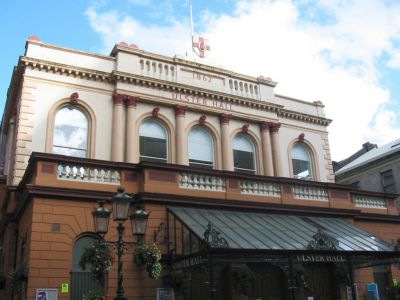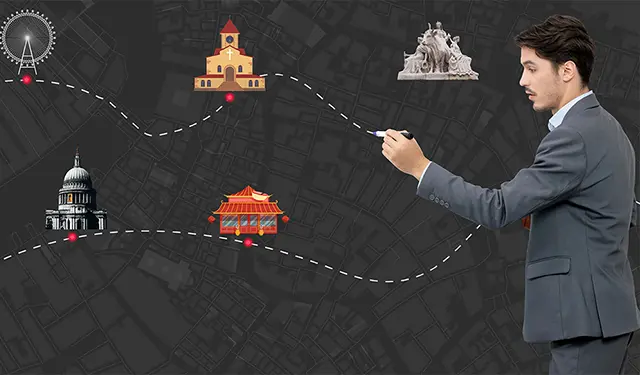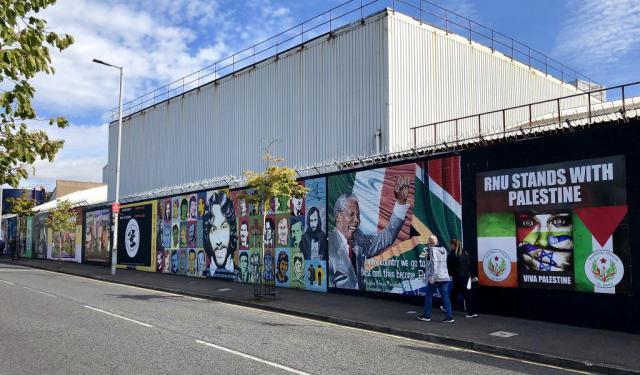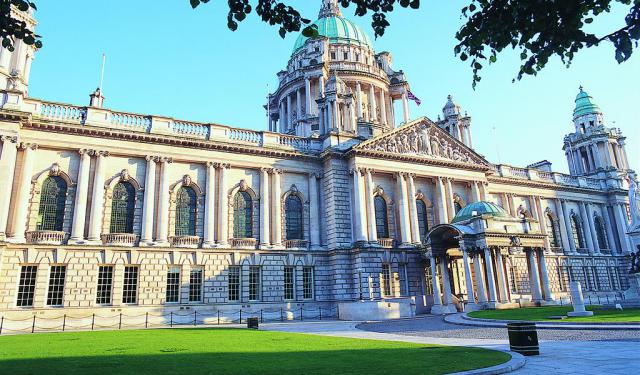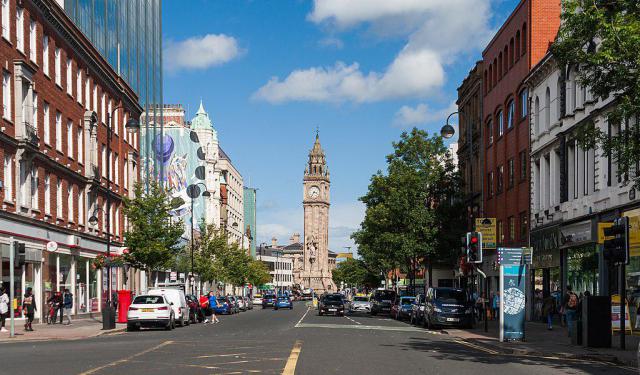Ulster Hall, Belfast
Ulster Hall is one of Northern Ireland’s most cherished cultural landmarks. Opened in May 1862 and designed by acclaimed Victorian architect William J. Barre, the hall was built to elevate Belfast’s artistic profile. Over a century and a half later, it remains a Grade A-listed jewel-fondly known as the "Grand Dame of Bedford Street"-with a beautifully restored red-brick façade, ornate columns, and an intricate iron-and-glass canopy that draws the eye of every visitor.
Walking through its doors, tourists encounter an interior rich in historic grandeur. The majestic Mulholland Grand Organ-a fine Victorian instrument donated in the 1860s-still commands attention from the stage. Along the walls, a series of atmospheric paintings by Joseph Carey depict the growing city's 19th-century landscape, adding a storytelling dimension to the space. A major refurbishment, completed in 2009, enhanced sightlines, reintroduced glazed windows, doubled capacity with a flexible ground-floor seating layout, and added modern amenities-all while preserving the hall’s classical charm.
Ulster Hall’s reputation is built on the legendary moments it has hosted. During World War II, it served as a dance hall beloved by American troops, later becoming Northern Ireland’s premier boxing venue, and from the 1960s onward, a spiritual home for rock music. Its stage has welcomed luminaries ranging from Charles Dickens and James Joyce to music icons like Led Zeppelin-who debuted “Stairway to Heaven” here in 1971-and contemporary stars like U2, Coldplay, Muse, and the Ulster Orchestra. Today, its calendar is a vibrant mix of live concerts, comedy nights, classical recitals, and even sporting events-a highlight of any visitor’s cultural itinerary.
With free entry to admire its artistry and guided tour options for deeper insight, this venue remains a captivating bridge between the city’s storied past and its exciting artistic present.
Walking through its doors, tourists encounter an interior rich in historic grandeur. The majestic Mulholland Grand Organ-a fine Victorian instrument donated in the 1860s-still commands attention from the stage. Along the walls, a series of atmospheric paintings by Joseph Carey depict the growing city's 19th-century landscape, adding a storytelling dimension to the space. A major refurbishment, completed in 2009, enhanced sightlines, reintroduced glazed windows, doubled capacity with a flexible ground-floor seating layout, and added modern amenities-all while preserving the hall’s classical charm.
Ulster Hall’s reputation is built on the legendary moments it has hosted. During World War II, it served as a dance hall beloved by American troops, later becoming Northern Ireland’s premier boxing venue, and from the 1960s onward, a spiritual home for rock music. Its stage has welcomed luminaries ranging from Charles Dickens and James Joyce to music icons like Led Zeppelin-who debuted “Stairway to Heaven” here in 1971-and contemporary stars like U2, Coldplay, Muse, and the Ulster Orchestra. Today, its calendar is a vibrant mix of live concerts, comedy nights, classical recitals, and even sporting events-a highlight of any visitor’s cultural itinerary.
With free entry to admire its artistry and guided tour options for deeper insight, this venue remains a captivating bridge between the city’s storied past and its exciting artistic present.
Want to visit this sight? Check out these Self-Guided Walking Tours in Belfast. Alternatively, you can download the mobile app "GPSmyCity: Walks in 1K+ Cities" from Apple App Store or Google Play Store. The app turns your mobile device to a personal tour guide and it works offline, so no data plan is needed when traveling abroad.
Ulster Hall on Map
Sight Name: Ulster Hall
Sight Location: Belfast, Ireland (See walking tours in Belfast)
Sight Type: Attraction/Landmark
Guide(s) Containing This Sight:
Sight Location: Belfast, Ireland (See walking tours in Belfast)
Sight Type: Attraction/Landmark
Guide(s) Containing This Sight:
Walking Tours in Belfast, Ireland
Create Your Own Walk in Belfast
Creating your own self-guided walk in Belfast is easy and fun. Choose the city attractions that you want to see and a walk route map will be created just for you. You can even set your hotel as the start point of the walk.
The Troubles and Peace Process Landmarks
Decades past the official end of The Troubles in Belfast, the price of peace in Northern Ireland remains high. One of the means with which to secure it, back in 1969, was erecting a wall to physically separate the capital's warring Protestant and Catholic communities. Known since as the Peace Wall, the structure has become a popular tourist attraction for the multiple murals painted thereon... view more
Tour Duration: 1 Hour(s)
Travel Distance: 2.1 Km or 1.3 Miles
Tour Duration: 1 Hour(s)
Travel Distance: 2.1 Km or 1.3 Miles
Belfast Victorian Architecture Jewels
Described as “modestly scaled, undemonstrative, somewhat solid in aspect, and usually restrained (sometimes even austere) in its use of external decoration”, the urban landscape of Belfast has been influenced by the demands of shipbuilding and linen industry, much as transitioning between culture, arts, commerce, and education. Still, the architectural spectrum of the city is quite broad and... view more
Tour Duration: 2 Hour(s)
Travel Distance: 2.9 Km or 1.8 Miles
Tour Duration: 2 Hour(s)
Travel Distance: 2.9 Km or 1.8 Miles
Belfast Introduction Walking Tour
For over a century, the political situation of Belfast, the capital of Northern Ireland, has been the source of strife, first between the Crown-loyal Protestants and Irish Catholics, and more recently between the United Kingdom and the European Union.
Sitting on the banks of the River Lagan where it meets the Irish Sea, the city owes its name to this coastal condition, with "Belfast"... view more
Tour Duration: 2 Hour(s)
Travel Distance: 3.8 Km or 2.4 Miles
Sitting on the banks of the River Lagan where it meets the Irish Sea, the city owes its name to this coastal condition, with "Belfast"... view more
Tour Duration: 2 Hour(s)
Travel Distance: 3.8 Km or 2.4 Miles
